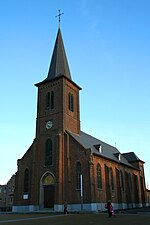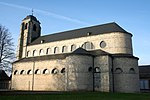Binche Palace
Buildings and structures completed in the 12th centuryBuildings and structures completed in the 16th centuryBuildings and structures demolished in 1704Castles in BelgiumCastles in Hainaut (province) ... and 3 more
Demolished buildings and structures in BelgiumUse British English from May 2023Use mdy dates from May 2023

Binche Palace (French: Palais de Binche) was a royal residence located in Binche, in today's Belgian province of Hainaut, Wallonia. The medieval castle and subsequent Renaissance palace served as residence for the counts of Hainaut, the dukes of Burgundy and the Habsburg rulers of the Netherlands. The palace was built between 1546 and 1549 by order of Queen Mary of Hungary, governor of the Netherlands, and was one of the first Renaissance palaces in the Low Countries, intended to rival the French Palace of Fontainebleau. It was destroyed by soldiers of King Henry II of France in 1554. Nowadays, only some medieval walls and foundations of the castle and palace remain.
Excerpt from the Wikipedia article Binche Palace (License: CC BY-SA 3.0, Authors, Images).Binche Palace
Faubourg du Posty, Binche
Geographical coordinates (GPS) Address External links Nearby Places Show on map
Geographical coordinates (GPS)
| Latitude | Longitude |
|---|---|
| N 50.408055555556 ° | E 4.165 ° |
Address
Château de Marie de Hongrie (Palais de Binche)
Faubourg du Posty
7131 Binche
Hainaut, Belgium
Open on Google Maps









